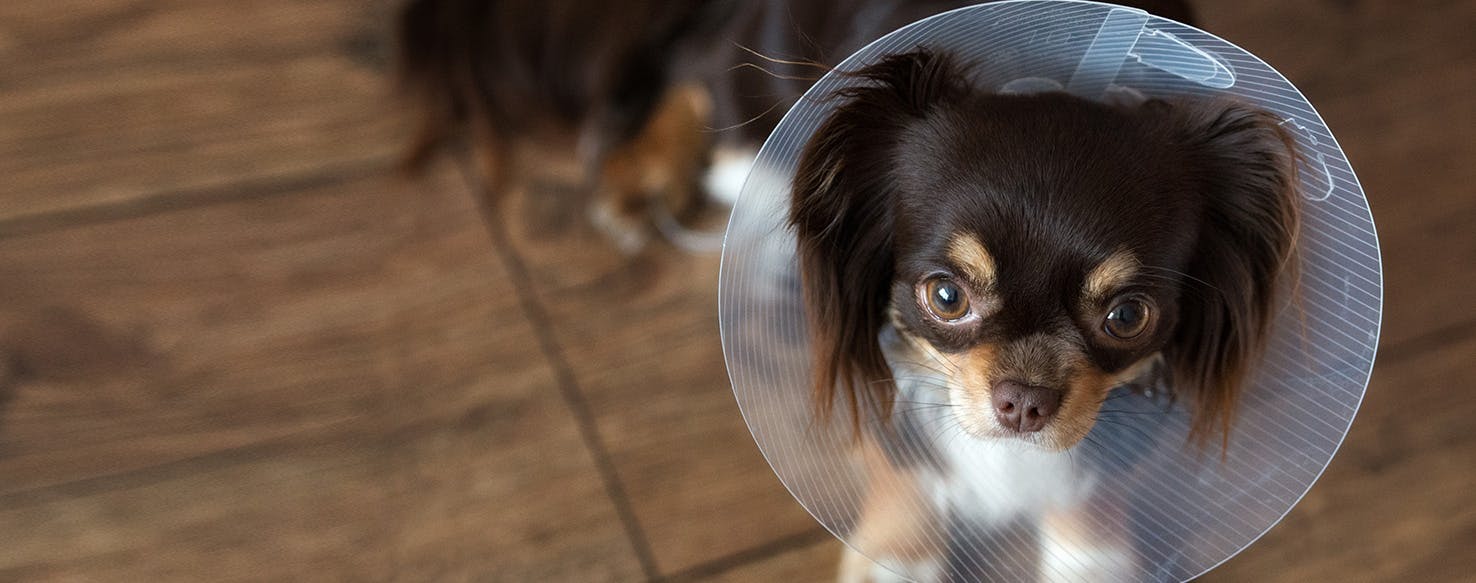
By Darlene Stott
Published: 10/02/2017, edited: 09/07/2022
Save on pet insurance for your pet
You don't have to choose between your pet and your wallet when it comes to expensive vet visits. Prepare ahead of time for unexpected vet bills by finding the pawfect pet insurance.
For many pet parents, having your dog endure a surgical procedure or suffer from an injury is difficult and emotionally exhausting. Knowing you must take your dog home wearing an Elizabethan, or E-collar as many veterinarians call it, or the “cone of shame”, as many pet parents refer to it, is enough to make pet parents shake their heads. Dealing with an E-collar on your dog can be as frustrating for you as it is for your dog. Watching your pet bang into walls and seeing the plastic cone sometimes cause a painful rash is difficult. You may feel discouraged and unable to help the situation.
Veterinarians are often asked if there are alternatives to Elizabethan collars and why a dog needs to wear one in the first place. Elizabethan collars are essential for your companion's recovery, but there are other options to collars, as well as alternatives if you and your veterinarian are open to discussing them.
What is a dog e-collar for?
Elizabethan collars are necessary because it is your dog's natural instinct to lick or nurse a surgical incision or wound. Caring for an injury is natural for your dog. Inadvertently ripping out stitches is often a side effect of your dog naturally caring for their injuries and wounds. Chewing on the skin or licking wounds could cause the incision to become reopened, as well as introduce bacteria to the wound, which could cause a secondary infection. With an Elizabethan collar, your dog's head is unable to get to the wound. An Elizabethan collar allows the injury to heal without your pup interrupting the healing process. These truncated cones prevent your dog from having the ability to turn and bite or lick their body.
What are the types of collars?
Most Elizabethan collars veterinarians and pet stores offer are made of plastic and resemble a lampshade. However, there are more gentle, softer, and easier to use alternatives to this tough plastic cone of shame. With the same shape as an Elizabethan collar, you might be able to find a soft fabric collar that still wraps around your dog’s neck keeping their head and mouth away from the wounds. These are almost like a neck brace and are effective, although whether this type is suitable depends where the wound is.
Flexible collars are available as an alternative to the harder plastic cones. These collars are typically foam, covered in nylon. They offer a softer option for your dog so as your dog lays down, the collar is almost pillow-like. Another alternative is an inflatable device. These inflatable collars resemble donuts around your dog’s neck. These devices are easy to store, are softer, and are typically smaller than an Elizabethan collar. However, if your pooch has sharp nails and insists on scratching, an inflatable collar may pop.
The T-Shirt Option
Another alternative to keeping your dog from having to wear an Elizabethan collar, while also keeping them from licking and chewing their wounds and injuries, is to dress your dog. Putting your dog in a t-shirt, whether child-sized for small dogs or adult-sized for larger dogs, can keep the wounds protected while keeping your companion's mouth away from the wound. If your dog is wearing an Elizabethan collar because of ear injuries, a t-shirt may not work. An Elizabethan collar or a softer alternative around their neck may be the only option for keeping your dog's paws out of their ears.
However, for many dogs who are spayed and neutered surgically, t-shirts are a perfect alternative to keeping your dog's incision safe, clean, and left alone to heal. If you choose to put a t-shirt on your dog and the waistline of the t-shirt is baggy, tie it in a simple knot on their back. This keeps it loose enough for comfort, yet tight enough so that it will not rise off of the wound, allowing your dog access for incessant licking and chewing.
The Wound Needs to Heal
The idea of an Elizabethan collar might feel a little old-fashioned. However, for some dogs and for some injuries, they are often a necessity. Visiting your emergency vet for a repair to a surgical incision because your dog has ripped out the stitches with their teeth, or caused a secondary infection because their mouth contains bacteria and they will not stop licking the wound, is probably not top on any pet parent’s list of things to do after a laceration or surgical wound.
Elizabethan collars can be large, making it difficult for your dog to maneuver around your home and can be stiff and unyielding. However, know they are essential to your dog's healing process, and they are temporary. However, you protect your dog's surgical site or wounds, be sure you are offering your dog something to give them time to heal.
If your dog is at risk of developing a skin infection due to constant licking, check out our pet insurance comparison tool. Wag! Wellness lets pet parents compare insurance plans from leading companies like Figo and Healthy Paws.
You may also like
